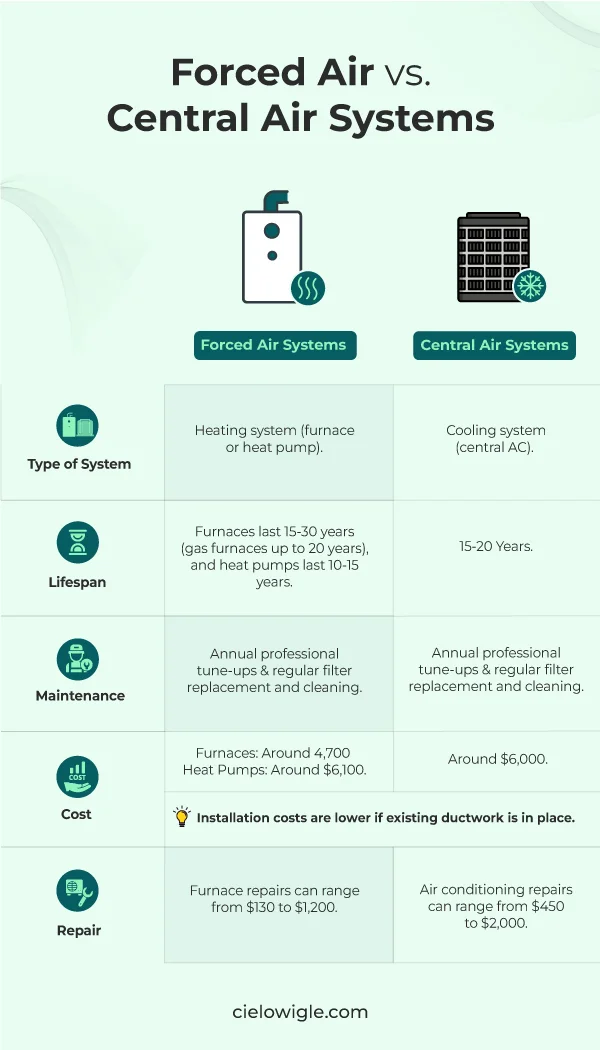
Key Takeaways
- Forced air systems primarily focus on heating (furnaces or heat pumps), while central air systems are dedicated to cooling (air conditioners).
- Both these systems can use the same ductwork to circulate conditioned air throughout the home.
Central air systems and forced air systems are often confused with each other, most likely because both systems utilize the same ducts and vents to force conditioned air throughout the house. However, they refer to distinct HVAC systems with specific functions.
Forced air systems are typically associated with heating and include a furnace or a heat pump to warm the air and circulate it through your home. In contrast, central air systems focus on cooling, using an air conditioner to distribute cool air.
This blog will explore the key distinctions between these systems, helping you make an informed choice about what best suits your heating and cooling needs.
What Is a Forced Air System?

It’s important to understand that while ‘forced air’ is commonly linked to heating, it actually covers a broader range of HVAC systems that use ducts to distribute conditioned air (warm or cold) throughout a home. This includes furnaces, heat pumps, and central air conditioners.
Note: This guide sticks to the commonly referred meaning to avoid any confusion.
Furnaces and heat pumps are commonly included in the forced air system. These units work by heating air and circulating it through ducts and vents to make your home warm and cozy. A thermostat is used for temperature adjustments on a forced air unit.
Related: Heat Pump vs. Furnace: The Best Way to Heat Your Home
When it comes to heat pumps, there are also ductless mini-split heat pumps that deliver air right where it is needed using indoor air handlers. They do not require any ductwork and can be installed in individual rooms.
Your best choice to make any mini-split, window,
or portable AC smart. Enhance your comfort and savings.

Pros & Cons of Forced Air Heating Systems
Forced Air Pros
- They can help improve indoor air quality by filtering out pollutants like dust, allergens, and other particles.
- Forced air systems are very energy-efficient, with less than 5% of fuel wasted during heating. Using an energy-efficient heat pump can help homeowners save over $500 annually on their energy bills.
- The initial cost of installing a forced-air system can be relatively lower than that of installing other heating systems, such as radiant floor heating, if you already have ductwork in place.
- Their operation is simple; you just have to use the thermostat to control them.
Forced Air Cons
- Large homes with long ductwork might experience uneven heating, with some areas being warmer or cooler than others.
- Regular HVAC maintenance, including cleaning ducts and changing filters frequently, is necessary to ensure optimal performance and air quality.
Related: The Ultimate Furnace Maintenance Guide for Maximizing Comfort & Savings
- Combustible fuels used in some forced-air systems can produce carbon monoxide, a potentially harmful gas if not properly vented.
- If your home doesn’t have ductwork, you will need to add it before installing a forced-air heating system, which can significantly increase the cost. In older homes, there might not be enough space to accommodate ductwork, making forced-air heating a less viable option.
- Since the furnace or heat pump is located inside your home, it can produce a lot of noise while it’s running.
| Advantages | Disadvantages |
|
|
|
|
|
|
|
|
What Is a Central Air Conditioner?

A central air conditioner is a system designed to cool an entire house or building.
It works by removing heat from the indoor air using a refrigerant. This process involves passing warm air over evaporator coils that absorb heat and then release the cooled air back into the home. The cooled air is circulated through the home via ducts and vents connected to a central unit, ensuring even cooling throughout different rooms. A thermostat regulates the temperature by turning the air conditioner on and off to maintain the desired indoor temperature.
Read this article to find out more about how your air conditioner works.
Central air conditioners come in two main types: split systems and packaged systems. Split systems are more commonly used and consist of two units—one inside your home and one outside. A packaged unit is a type where all the components are housed in a single, compact unit.
Pros & Cons of a Central Air Conditioner
Central Unit Pros
Here are some advantages of central air conditioning:
- Central AC can cool your entire home uniformly, making it more convenient than using multiple room air conditioners, including mini-splits, portable units, or window air conditioners.
- Since these units are outside, they tend to be quieter than many other types of air conditioners and forced-air systems, providing a more peaceful indoor environment.
- Many central AC systems include filters that help remove dust, pollen, and other allergens from the air, contributing to better indoor air quality.
- Controlled by a thermostat, central AC allows for easy and precise temperature adjustments throughout your home.
Central Unit Cons
- If your home doesn’t already have ductwork, adding central air conditioning can be expensive and complicated. The cost of installing new ductwork can average around $3500.
- Cooling an entire home with central air can lead to higher energy costs compared to using smaller, individual units for specific rooms. However, you can manage costs by using a smart thermostat to turn your AC on and off based on your schedule.
- The outdoor unit of a central air system is bulky and needs adequate space in your yard. If outdoor space is limited, installing a central air system may not be feasible.
- If the ductwork is not well-maintained or is poorly designed, it can lead to inefficiencies, such as air leaks or HVAC airflow problems, which may affect overall system performance.
Equip your HVAC system with smart features and achieve the perfect balance between comfort & savings.
Learn more
| Advantages | Disadvantages |
|
|
|
|
|
Forced Air vs. Central Air
Here’s a look at how these two systems are alike and how they differ:

-
Ease of Installation
Both central air and forced air systems need to be installed by a professional. It’s best to choose a reputable installer to ensure the system is set up correctly and will work efficiently for years.
-
Lifespan
The lifespan of your HVAC unit varies depending on its type. Central AC units generally last between 15 to 20 years. Furnaces can last from 15 to 30 years, though gas furnaces usually have a shorter lifespan of up to 20 years. Heat pumps typically last between 10 to 15 years.
Related: 8 Ways to Extend the Average Life of AC Unit
-
Maintenance
Both central air conditioning and forced-air systems require similar maintenance tasks, such as annual preventative maintenance activities performed by a professional and regular filter replacement or cleaning.
-
Cost
The price of the two systems isn’t significantly different. The actual cost can vary based on the type of unit you choose to install and whether or not you already have existing ductwork. If ductwork is already in place, installation may be less expensive than installing a system and the ductwork.
An AC unit usually costs about $6,000. Installing a new furnace typically costs around $4,700, and heat pumps are more expensive, averaging around $6,100.
-
Repair
Forced air systems usually incur lower repair costs compared to central air systems. While air conditioning repairs can range from $450 to $2,000, furnace repairs typically cost between $130 and $1,200.
Choosing Forced Air vs. Central Air for Your Home
When deciding between forced air and central air systems for your home, it’s essential to consider factors such as efficiency, installation costs, and long-term benefits. Forced air systems are known for their efficiency in distributing heat quickly. You can also use heat pumps to get the advantage of both heating and cooling in one appliance. Central air systems, on the other hand, provide consistent and even cooling throughout the home. However, you will require a separate heating system. Ultimately, the best choice will depend on your specific needs, budget, and the existing infrastructure of your home. By weighing these considerations carefully, you can select the system that will provide optimal comfort and efficiency for your household.








